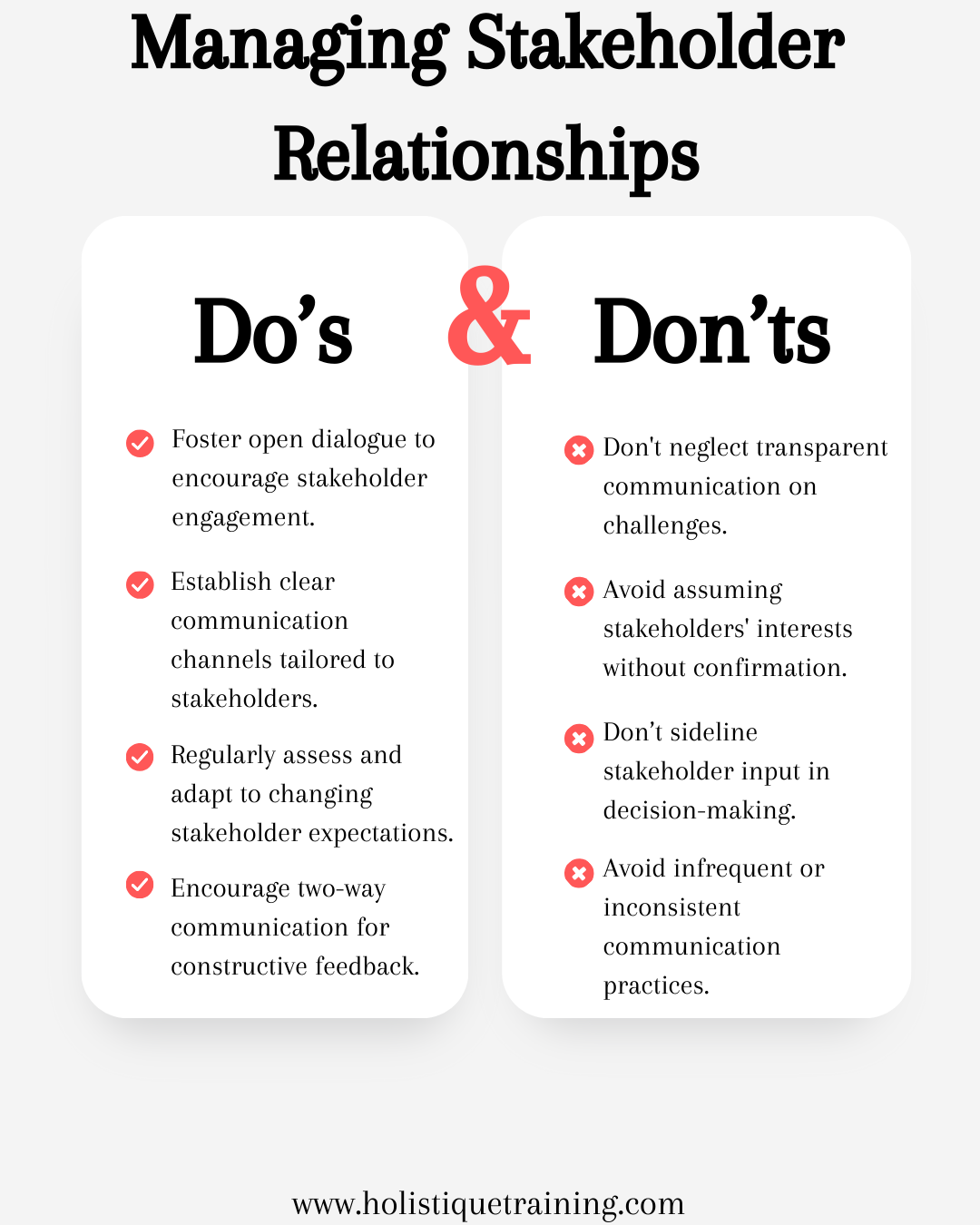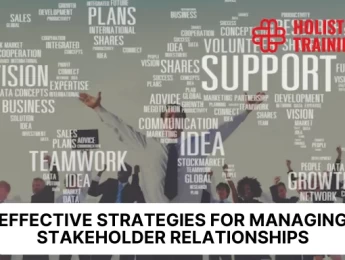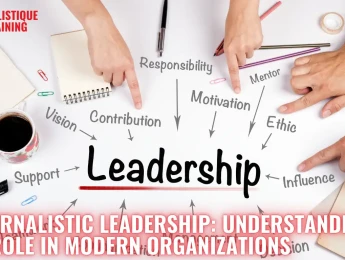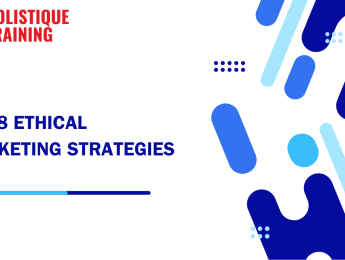Introduction
As businesses navigate the complex landscape of today's dynamic market, the significance of managing stakeholder relationships cannot be overstated. Stakeholders, the diverse groups that hold a stake or interest in a project or organisation, play a pivotal role in shaping its trajectory. Effective stakeholder management is not merely a box to be checked but a nuanced process that demands attention, empathy, and strategic finesse. In this comprehensive exploration, we delve into the intricacies of managing stakeholder relationships, examining the common groups, the underlying importance, the process, and offering practical tips for success.
What Is Stakeholder Management?
Stakeholder management is the deliberate and systematic effort to understand, engage, and influence the individuals, groups, or organisations that can significantly impact or be impacted by a project or business initiative. These stakeholders, often wielding diverse interests and expectations, can range from internal team members to external clients, investors, regulatory bodies, and community representatives.
Common Stakeholder Groups
Identifying the key players in your project or business ecosystem is fundamental to effective stakeholder management. Common stakeholder groups include:
1- Internal Stakeholders
Internal stakeholders are individuals or groups within the organisation directly impacted by its decisions and actions. This category includes employees, managers, and executives. Their perspectives are shaped by the internal dynamics and culture, making their engagement pivotal for a project's success.
2- External Customers
Customers are perhaps the most obvious external stakeholders. Their satisfaction is paramount for business success. Understanding their needs, expectations, and concerns is essential for delivering products or services that not only meet but exceed their expectations.
3- Suppliers and Partners
Suppliers and business partners form a crucial external stakeholder group. Effective collaboration with suppliers ensures the timely delivery of goods and services, while strategic partnerships can open avenues for innovation and mutual growth.
4- Government and Regulatory Bodies
Depending on the industry, compliance with laws and regulations is vital. Government agencies and regulatory bodies influence the operational landscape. Building a positive relationship with them ensures smooth operations and mitigates the risk of legal issues.
5- Investors and Shareholders
Investors and shareholders have a direct financial stake in the organisation. They are interested in the company's profitability, financial health, and long-term sustainability. Transparent communication with this group is key to maintaining trust and confidence.
6- Local Communities
Organisations often operate within specific geographic locations, and the surrounding communities can significantly impact or be impacted by their activities. Engaging with local communities fosters goodwill, addresses concerns, and supports sustainable development.
7- Media and Public
The media and the public play a crucial role in shaping an organisation's reputation. Positive coverage can enhance brand image, while negative publicity can have detrimental effects. Managing relationships with the media and the public requires a proactive and transparent approach.
8- Competitors
While not traditional collaborators, competitors are important stakeholders to monitor. Understanding their strategies, market positioning, and potential collaborations can provide valuable insights for adapting and staying competitive in the industry.
Recognising the diversity within these stakeholder groups is essential. Each group has distinct interests, expectations, and communication preferences. Tailoring engagement strategies to address these specific needs lays the foundation for effective stakeholder management.
As we explore the importance of managing stakeholder relationships, the role of each group becomes more apparent, showcasing the intricate web of connections that organisations must navigate for sustained success.
Why Is It Important to Manage Stakeholder Relationships?
The stakes are high when it comes to stakeholder management. Here's why it's crucial:
Alignment of Goals and Objectives
Stakeholder management facilitates the alignment of diverse goals and objectives within and outside the organisation. By understanding and incorporating the interests of various stakeholders, businesses can ensure that their strategies resonate with the broader ecosystem. This alignment creates a shared vision, fostering unity and synergy across different facets of the operation.
Risk Mitigation
Stakeholders often wield the power to influence an organisation's trajectory. By actively engaging with them, businesses can identify potential risks early on. This proactive approach allows for the development of mitigation strategies, minimising the impact of unforeseen challenges and enhancing the organisation's resilience.
Enhanced Decision-Making
Informed decision-making relies on comprehensive insights into the implications and repercussions of choices. Through effective stakeholder management, organisations can tap into the collective wisdom of those who have a vested interest in the outcomes. This inclusive decision-making process often results in more robust, well-rounded choices.
Operational Efficiency
Stakeholders, particularly internal ones, are integral to the day-to-day operations of an organisation. By fostering positive relationships with employees, managers, and executives, businesses can cultivate a culture of collaboration and efficiency. Engaged employees are more likely to contribute creatively, leading to increased productivity and innovation.
Brand and Reputation Management
The perception of an organisation by its stakeholders profoundly influences its brand and reputation. Through effective communication and relationship management, businesses can shape positive perceptions, build trust, and enhance their overall image. Conversely, neglecting stakeholder relationships can result in reputational damage that may take years to repair.
Adaptability to Change
The business landscape is in a constant state of flux. Effective stakeholder management enables organisations to navigate change with agility. By keeping stakeholders informed and involved, businesses can garner support during transitions, ensuring a smoother adaptation to market shifts, technological advancements, or internal restructuring.
Resource Mobilisation
Stakeholders often provide essential resources, whether in the form of financial investments, expertise, or partnerships. Cultivating strong relationships with investors, suppliers, and strategic partners can unlock valuable resources that fuel growth and innovation, giving the organisation a competitive edge.
Regulatory Compliance
In industries subject to stringent regulations, maintaining positive relationships with regulatory bodies is crucial. Stakeholder management ensures that an organisation stays abreast of regulatory changes, complies with requirements, and builds constructive relationships with governing bodies.
Sustainable Development
Today's businesses are increasingly recognising the importance of sustainable practices. Engaging with stakeholders, including local communities and environmental advocates, is essential for developing and implementing responsible and sustainable business practices.
In essence, managing stakeholder relationships is not a peripheral aspect of business strategy; it is a fundamental driver of success. The interconnected nature of the business ecosystem requires organisations to view stakeholders not merely as external entities but as integral contributors to their journey. As we delve into the stakeholder management process, it becomes evident that the dividends reaped from these relationships extend far beyond the immediate project or initiative—they shape the very foundation of organisational prosperity.
The Stakeholder Management Process
Managing stakeholder relationships is not a one-size-fits-all endeavour. It involves a cyclic process with the following key phases:
1- Identification of Stakeholders
The journey begins with identifying the various stakeholders associated with a project, initiative, or the organisation as a whole. This involves casting a wide net to capture internal and external entities that can influence or be affected by the endeavour. Stakeholders can range from employees and customers to regulatory bodies and community representatives.
2- Stakeholder Analysis
Once identified, stakeholders undergo a thorough analysis. This involves assessing their interests, expectations, concerns, and potential impact on the project or organisation. Analysing their level of influence and the degree of interest they hold helps categorise stakeholders into groups, such as high-power players, key influencers, or those with minimal impact.
3- Prioritisation of Stakeholders
Not all stakeholders are created equal in terms of their impact on the project or their level of interest. Prioritisation involves ranking stakeholders based on their significance. High-priority stakeholders may require more intensive engagement and communication efforts, while lower-priority ones may receive more general updates.
4- Developing a Stakeholder Engagement Plan
Statistics show that stakeholder engagement is the most crucial process for project success, with 50% of respondents underscoring its pivotal role in achieving positive outcomes. With a clear understanding of who the stakeholders are and their priorities, organisations can now craft a comprehensive engagement plan. This plan outlines how the organisation will interact with each stakeholder group, the frequency and mode of communication, and the strategies for addressing specific concerns or expectations.
5- Communication Strategies
Communication is the lifeblood of stakeholder management. Tailoring communication strategies to the preferences of each stakeholder group ensures that the right messages are conveyed in the most effective manner. This may involve regular meetings, reports, newsletters, or even interactive workshops, depending on the nature of the stakeholders and the project.
6- Building Relationships
Beyond formal communication, building relationships is about establishing trust and rapport with stakeholders. This goes beyond addressing their immediate needs and concerns—it involves actively listening to their feedback, involving them in decision-making processes, and demonstrating a commitment to their long-term interests.
7- Feedback Mechanisms
A crucial aspect of effective stakeholder management is creating mechanisms for feedback. Encouraging stakeholders to share their thoughts, concerns, and suggestions fosters a culture of openness. Regular feedback loops enable organisations to adapt their strategies in response to evolving stakeholder expectations.
8- Monitoring and Adaptation
The stakeholder management process is not a one-time affair; it requires continuous monitoring and adaptation. As projects evolve and circumstances change, stakeholder dynamics may shift. Organisations must remain agile, revisiting their stakeholder analysis and engagement plans to ensure they remain relevant and effective.
9- Conflict Resolution
In the complex world of stakeholder relationships, conflicts are inevitable. Having mechanisms in place to address conflicts promptly and constructively is vital. This may involve facilitated dialogues, mediation, or, in extreme cases, escalation to higher levels of management.
10- Continuous Improvement
A commitment to continuous improvement is integral to the stakeholder management process. Evaluating the effectiveness of engagement strategies, learning from successes and challenges, and incorporating these insights into future initiatives contribute to the organisation's ability to adapt and thrive.
The stakeholder management process is not a linear path but a dynamic and iterative cycle. Successful organisations recognise that stakeholder management is not a checkbox but an ongoing commitment to understanding, engaging, and collaborating with those who shape and are shaped by the organisation's endeavours. As we delve into practical tips for managing relationships with stakeholders, these foundational steps lay the groundwork for a comprehensive and effective stakeholder management strategy.
Table 1: Metrics to Measure the Effectiveness of Managing Stakeholder Relationships
Metric | Description | Measurement Approach |
Stakeholder Satisfaction | Gauge stakeholder contentment and feedback. | Surveys, feedback sessions, ratings. |
Communication Effectiveness | Assess clarity, frequency, and responsiveness of communication. | Analyse feedback, response times, message recall. |
Issue Resolution Time | Measure time taken to resolve stakeholder issues. | Tracking ticket resolution times, customer feedback. |
Engagement Level | Evaluate the degree of stakeholder involvement. | Participation rates, attendance, interaction frequency. |
Impact on Project Goals | Assess how stakeholder engagement contributes to objectives. | Alignment with goals, measurable contributions, success indicators. |
8 Tips for Managing Relationships with Stakeholders
Effective stakeholder management is a delicate dance that requires finesse, empathy, and strategic acumen. Building and maintaining positive relationships with stakeholders is not just a checkbox on a project management list; it is an art that, when mastered, can elevate an organisation's success. Here are eight practical tips to guide you in this intricate journey:
1- Understand Stakeholder Needs and Expectations
Begin by thoroughly understanding the needs, expectations, and concerns of each stakeholder group. This insight forms the foundation for tailoring your communication and engagement strategies. Consider conducting surveys, interviews, or focus groups to gather valuable input directly from stakeholders.
2- Customise Communication Channels
Recognise that different stakeholders have diverse communication preferences. Some may prefer face-to-face interactions, while others may favour written updates. Tailor your communication channels to match the preferences of each group. This might involve a combination of email updates, in-person meetings, webinars, or even social media engagement.
3- Be Transparent and Honest
Trust is the bedrock of any successful relationship. Transparency and honesty in your communications build trust with stakeholders. Acknowledge challenges, share progress, and admit mistakes when they occur. Being forthright demonstrates integrity and a commitment to open dialogue.
4- Establish Clear Expectations
Set clear expectations from the outset. Clearly define the scope of the project, the roles and responsibilities of each stakeholder group, and the anticipated outcomes. Clarity in expectations minimises misunderstandings and ensures that everyone is on the same page.
5- Proactive Issue Management
Anticipate potential issues and proactively address them before they escalate. Regularly assess the risk landscape and have contingency plans in place. If issues do arise, address them promptly and involve relevant stakeholders in the resolution process. A proactive approach demonstrates your commitment to minimise disruptions.
6- Provide Regular Updates
Communication should be a continuous process, not a sporadic event. Provide regular updates to stakeholders, keeping them informed about project progress, milestones achieved, and any changes in direction. Consistent communication reinforces your commitment to transparency and keeps stakeholders engaged.

7- Seek Stakeholder Feedback
Actively seek feedback from stakeholders. Establish mechanisms for them to share their thoughts, concerns, and suggestions. Regular feedback loops not only provide valuable insights but also demonstrate that their opinions are valued. Use this feedback to make informed adjustments to your strategies.
8- Celebrate Successes Together
Celebrate achievements, both big and small, with your stakeholders. Recognising and appreciating their contributions fosters a positive atmosphere. Whether it's a project milestone, a successful campaign, or hitting a target, sharing successes creates a sense of shared accomplishment and reinforces the collaborative nature of the relationship.
Remember, managing stakeholder relationships is a dynamic process that requires ongoing effort and adaptability. These tips serve as a compass, guiding you through the intricate terrain of stakeholder engagement. As we delve into effective communication strategies with stakeholders, keep these principles in mind to build lasting and mutually beneficial relationships that contribute to the overall success of your projects and initiatives.
How to Communicate Effectively with Stakeholders
Effective communication lies at the heart of successful stakeholder management. The ability to convey information clearly, listen actively, and engage stakeholders in a meaningful way is crucial for building and sustaining positive relationships. Here are key strategies to ensure that your communication with stakeholders is not just informative but also fosters understanding and collaboration:
Know Your Audience
Tailor your communication to the specific needs and interests of each stakeholder group. Recognise that different groups may have varying levels of familiarity with the project or initiative. Understanding your audience allows you to speak their language, making your messages more relatable and impactful.
Use Clear and Concise Language
Avoid jargon and technical language that may be confusing to non-experts. Use clear, straightforward language to convey your messages. This ensures that all stakeholders, regardless of their background or expertise, can easily grasp the information you are sharing.
Choose the Right Communication Channels
Different stakeholders prefer different communication channels. Some may prefer face-to-face meetings, while others may prefer email or online collaboration tools. Understand the preferences of your stakeholders and use a mix of channels to ensure that your messages reach them effectively.
Establish a Regular Communication Cadence
Consistency is key in stakeholder communication. Establish a regular communication cadence to keep stakeholders informed. Whether it's weekly updates, monthly reports, or quarterly reviews, a predictable schedule helps stakeholders anticipate and engage with your communications.
Be Transparent and Honest
Transparency builds trust. Be open and honest about project progress, challenges, and decision-making processes. Address concerns and provide explanations when things don't go as planned. A transparent approach fosters a culture of trust and credibility.
Encourage Two-Way Communication
Communication is not just about broadcasting information; it's a two-way street. Create opportunities for stakeholders to share their thoughts, concerns, and feedback. Actively listen to their perspectives, and incorporate their input into decision-making processes when possible.
Provide Context and Relevance
Frame your messages in the broader context of the project or organisation. Help stakeholders understand how their contributions fit into the larger picture. Providing context gives stakeholders a sense of purpose and helps them see the value of their involvement.
Use Visuals to Enhance Understanding
Visual aids, such as charts, graphs, and infographics, can enhance the understanding of complex information. Visuals are particularly useful when presenting data or illustrating project timelines. They make information more accessible and engaging for a diverse audience. Not only that but statistics also show that presentations incorporating visual aids have a persuasive edge, with a 43% greater impact compared to their counterparts lacking visual elements.
Anticipate and Address Concerns
Proactively address potential concerns before they become major issues. Acknowledge stakeholders' worries and provide reassurance or solutions. This proactive approach demonstrates your commitment to their well-being and helps prevent misunderstandings.
Be Adaptable and Responsive
Communication needs can evolve throughout a project. Be adaptable and responsive to changes in stakeholder expectations or circumstances. If there are shifts in priorities or new information emerges, adjust your communication strategies accordingly.
By incorporating these communication strategies into your stakeholder management approach, you can create an environment of transparency, trust, and collaboration. Effective communication not only keeps stakeholders informed but also empowers them to contribute meaningfully to the success of the project or organisation. As we explore potential obstacles in managing stakeholder relationships, remember that clear and thoughtful communication is a powerful tool for overcoming challenges.
Conclusion
In the intricate dance of stakeholder management, where interests intersect and perspectives diverge, the art lies in navigating these complexities with finesse. From identifying and prioritising stakeholders to cultivating transparent communication and overcoming inevitable obstacles, effective stakeholder management is a dynamic process that goes beyond project timelines. It is a commitment to building lasting relationships that transcend the immediate goals, contributing to the organisation's resilience, adaptability, and sustained success. By understanding the importance of managing stakeholder relationships, implementing thoughtful communication strategies, and addressing potential obstacles head-on, organisations can foster an ecosystem where collaboration thrives, trust flourishes, and collective achievements become the hallmark of a well-managed journey.
Intrigued by the intricacies of stakeholder management? Elevate your skills with our comprehensive course on Stakeholder Engagement & Management. Dive deep into the art of building and nurturing relationships, mastering the techniques of effective communication, and overcoming challenges seamlessly. Empower yourself with strategies to navigate the dynamic landscape of stakeholder dynamics. Our course is designed to equip you with the insights and practical tools needed to lead successful stakeholder initiatives, ensuring your organisation not only meets its immediate objectives but flourishes in the long run. Enrol today and embark on a journey to become a master of stakeholder engagement, guiding your organisation towards resilience, adaptability, and enduring success.























